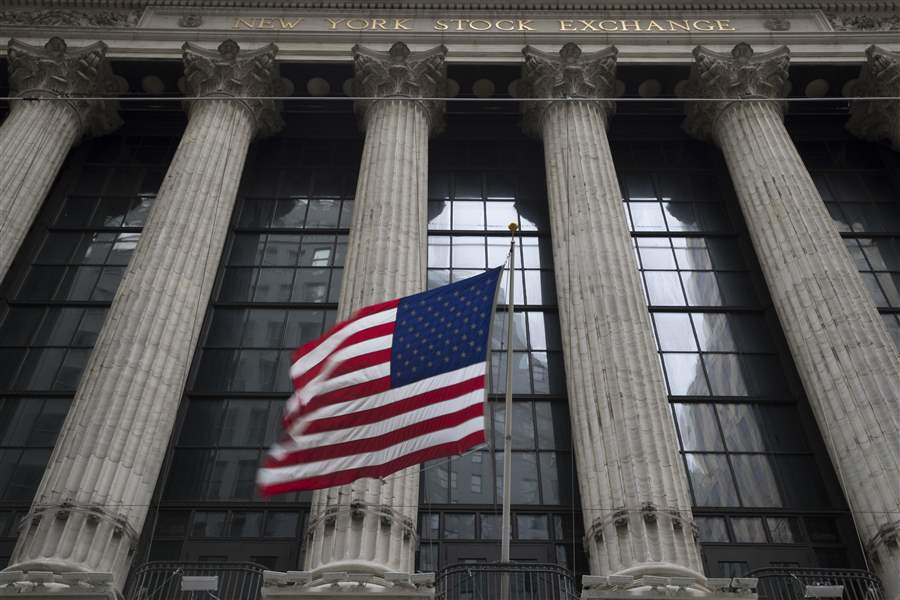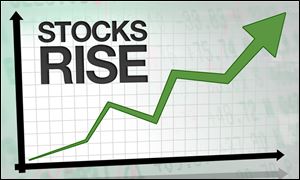
US stocks edge higher as technology, retail companies rise
6/5/2018
An American flag flies outside the New York Stock Exchange in New York.
ASSOCIATED PRESS
NEW YORK — U.S. stocks finished mostly higher Tuesday as weeks of up-and-down trading, much of it related to trade tensions, gave way to smaller moves. Technology companies, retailers, and U.S.-focused companies kept rising while banks fell with interest rates.
The market spent the day alternating between small gains and losses. Technology companies like Apple and eBay rose for a third straight day and the Nasdaq composite again set an all-time high.
The Labor Department said job openings increased in April, which could help lead to higher pay and greater consumer spending. Retailers climbed, and smaller ones fared especially well following some strong first-quarter results. Larger companies like Amazon and Macy’s also rose.
“When people have extra income they’re going to spend it on discretionary goods,” said Jason Draho, the head of asset allocation for UBS. “The jobs data would suggest a lot of job openings (and) that’s going to lead to higher wage growth.”

RELATED: Searchable stock index
However banks fell along with interest rates and health care companies also traded lower. Starbucks fell after it said longtime Chairman Howard Schultz is leaving the company.
The S&P 500 added 1.93 points, or 0.1 percent, to 2,748.80. The Dow Jones industrial average slipped 13.71 points, or 0.1 percent, to 24,799.98. The Nasdaq composite rose 31.40 points, or 0.4 percent, to 7,637.86 and the Russell 2000 climbed 11.25 points, or 0.7 percent, to 1,664.63.
The Nasdaq, which includes a heavy weighting of technology companies, and the Russell, an index comprised of smaller and more U.S.-focused companies, are at record highs. The S&P 500 is still 4 percent below the record it set on Jan. 26, and the Dow will have to rally 7 percent to reach the mark it set the same day.
The Labor Department said that for the first time since records began in December 2000, there are more job openings than unemployed Americans. That could give workers more leverage for pay raises, while high levels of employment and greater consumer spending are expected to lead to faster economic growth in the coming months.
Retailers helped lead the way Tuesday as more of them reported quarterly results. G-III Apparel Group climbed 10.8 percent to $47.53 after it raised its annual profit and sales forecast following a strong first quarter. Ascena Retail shook off early losses and rose 7.9 percent to $3.95.
Amazon again finished at a record high after it jumped 1.9 percent to $1,696.35 while Target gained 2.8 percent to $78.50 and Macy’s jumped 8 percent to $40.05.
Jason Draho of UBS said smaller companies are leading the market because they’re seen as less vulnerable to tariffs and trade disputes, and because economic growth in the U.S. is picking up while Europe and other regions don’t look quite as strong. He added that technology companies did well in the first quarter, and big companies including Apple and Facebook have shaken off some recent struggles.
Starbucks fell after Howard Schultz said he’s stepping down as the coffee chain’s chairman. Schultz has been chairman of the company since 2000 and oversaw enormous expansion for Starbucks over that time. He stepped away as CEO in 2000 but returned in 2008, and relinquished that title to Kevin Johnson in 2017. The stock lost 2.4 percent to $55.68.
S&P Dow Jones Indices said late Monday that Twitter will be added to the benchmark S&P 500 index as of Thursday after Monsanto officially becomes part of Bayer. Twitter rose 5.1 percent to $39.80. Netflix, which will become part of the S&P 100 index, rose 1.1 percent to $365.80.
Bond prices rose. The yield on the 10-year Treasury note fell to 2.92 percent from 2.94 percent.
Financial companies fell in tandem with bond yields. Lower yields force interest rates down on mortgages and other kinds of loans, which means lower profits for banks. Morgan Stanley lost 1.5 percent to $50.78 and Capital One gave up 1.1 percent to $94.35.
Mylan climbed 3.8 percent to $39.98 after federal regulators approved its version of Amgen’s anti-infection drug Neulasta. The Mylan drug, Fulphila, is called a biosimilar, meaning it’s the generic equivalent of a complex biotech drug, and it’s approved to reduce the risks of infections during treatment for cancer. Amgen lost 2 percent to $181.73.
Oil prices moved higher. Crude hit a three-year high of $72 a barrel on May 21 but has declined sharply over the past two weeks. U.S. crude picked up 1.2 percent to $65.52 a barrel in New York. Brent crude, used to price international oils, added 0.1 percent to $75.38 a barrel in London.
Wholesale gasoline lost 0.8 percent to $2.11 a gallon. Heating oil slipped 0.5 percent to $2.14 a gallon. Natural gas sank 1.4 percent to $2.89 per 1,000 cubic feet.
The dollar rose to 109.76 yen from 109.58 yen. The euro slipped to $1.1715 from $1.1719.
Gold rose 0.4 percent to $1,302.20 an ounce. Silver added 0.7 percent to $16.54 an ounce. Copper jumped 2 percent to $3.20 a pound.
Germany’s DAX rose 0.1 percent and the French CAC 40 dipped 0.2 percent. Britain’s FTSE 100 dropped 0.7 percent.
Japan’s benchmark Nikkei 225 index rose 0.3 percent and South Korea’s Kospi gained 0.3 percent. In Hong Kong the Hang Seng rose 0.3 percent.